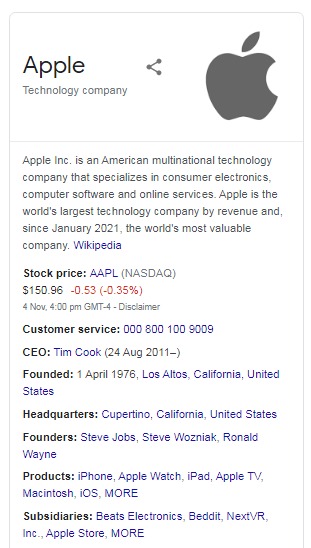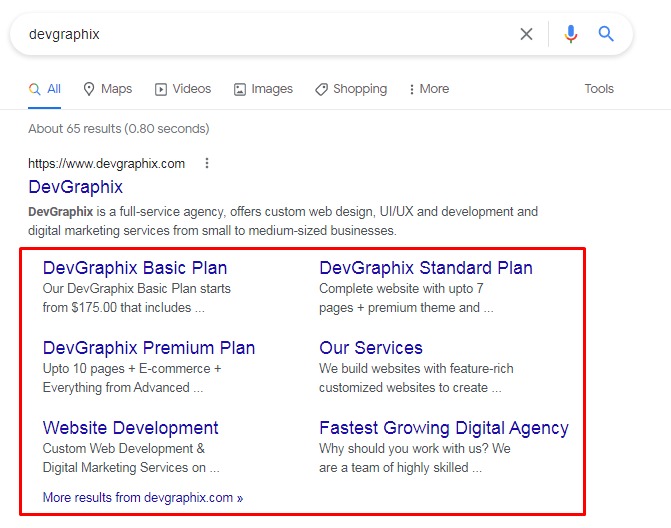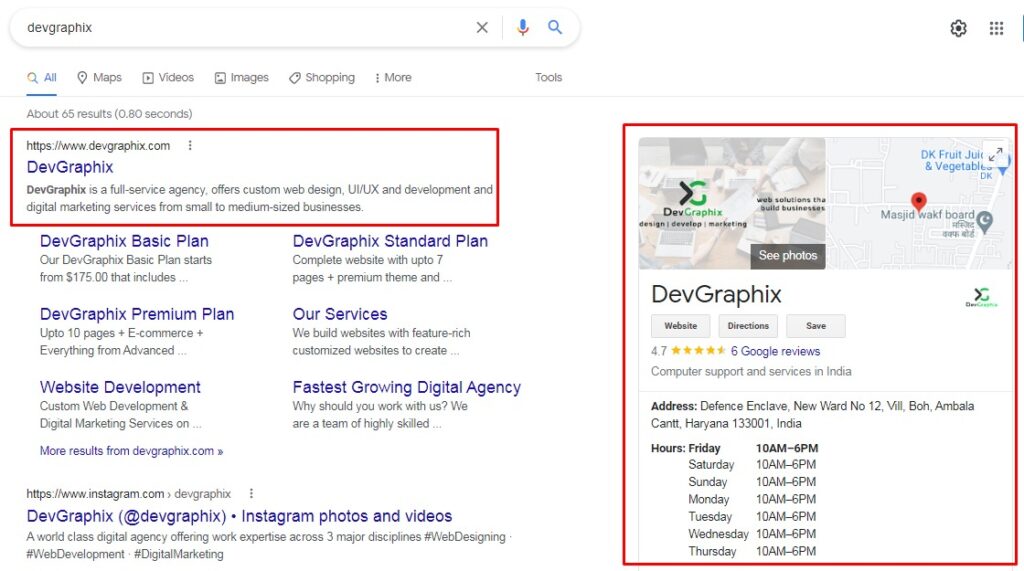Every business owner dream is to get #1 on Google search results with huge organic traffic for their business or brand, so they were focusing on rankings, Of course, it’s the most preferable method to get organic traffic. While improving rankings, focusing on increasing clicks is also an effective way to appear on SERPs. But how do get more clicks? There are several ways to get organic CTR, but Google Sitelinks are the best and an effective way more than others.
What is Sitelink Schema?
Sitelink schema is nothing but Google Sitelinks or organic Sitelinks. These are hyperlinks to subpages of a website that display under specific Google listings to assist users in navigating the site. These are SERP feature that increases click-through rates (CTR), increases brand reputation and trust, and encourage users to explore your website further.
Google adds sitelinks using its own secret automated algorithms, which the site owner has no control over.They’re designed to help users in navigating your website. Google examines your site’s link structure for shortcuts that will save consumers time and allow them to find the information.
Most Common Sitelink Schema Markup Types
Schema markup, also known as structured data, is the language of search engines, using a unique semantic vocabulary. It’s a type of coding that helps search engines better understand your content so that they can offer more detailed and relevant results to users.
There are three most common schema markup types, which are JSON-LD, Microdata, and RDFa. Also, schema markup is useful for all forms of content including, articles, ratings, reviews, events, games, movies, etc. As a result, there are hundreds of different markup kinds that can help you rank higher in search results. A few of them listed below –
1. Organization Schema
The organization schema markup aids in the generation of brand signals, which can improve the visibility of your Knowledge Graph entry and website snippet in search engine results pages (SERPs). It includesthe organization’s logo, website address, social media profiles, hours of operation, and contact information.

2. Navigation Schema
Site Navigation Element markuphelp search engines and users better understand your website’s structure and improve navigation. With this, you can influence Googlesitelinks to increase click-through rates for your site’s links.
You can use site navigation markup to direct visitors to your site’s subpages with up to six pages listed below your title tag and meta description. For your site’s subpages, each site link can have its own title tags and meta descriptions.These site links are a perfect way to drive traffic to specific pages on your site, and you can even use the site navigation schema markup to create the “About Us” or ‘Contact Us’ site link.

3. Local Business Schema Markup
Using the Postal Address or Local Business schema markup is one of the most effective methods for small and local businesses to enhance traffic and conversions. This markup can be implemented on sites that have a physical location as it issued to display information for individual business or organization branches such as an address, contact information, opening hours, menu, etc.
This is a great way to boost local business visibility while also improving the user experience for users on the verge of converting.During the COVID-19 epidemic, local business advertising can additionally display up-to-date information about dine-in service, takeout, and delivery for eateries.

4. Breadcrumbs Schema Markup
Breadcrumb linking is an excellent technique to improve user experience and search engine rankings on your website.
It allows you to mark up your site’s breadcrumbs to generate breadcrumb-rich snippets in the SERPs. It reveals the path users take to reach a certain page using the breadcrumb linking on your site. This makes it easier for users to move across your site after leaving the search engine results page and reduces bounce rates.

5. E-commerce Schema Markup – Rating, Products & Offers
Rating, product, and offer markups are essential schema markups for every shopping site, and they can significantly increase your business visibility in SERPs. It displays product information such as prices and availability under the title tag for your specified products.
A rating schema markupis primarily used only for e-commerce sites, but now it also can be used for local businesses such as restaurants, shopping malls to rate their services on a scale of one to five stars.

How Do I Get Sitelinks in SERP?
Google pulls in sitelinks automatically through its internal algorithms. So there is no specific action to add Google sitelinks manually. As long as your website satisfies Google’s required schema markup, then you will reach sitelinks in SERP with its two or three Search Results Pages.
As stated, you cannot ask Google which pages to use as sitelinks, they are selected by the Google algorithm based on the user’s query.However, there are a few things you can do to make Google understand your site’s structure and content, which will improve your chances of receiving sitelinks in the search results.
- Make sure to rank first for your brand name in search results
- Add structured data – Rich Snippets or Schema Markup as required
- Use simple site structure for easy understanding
- Generate and submit XML sitemap in search console
- Link sitelink pages from your homepage
- Update relevant titles and descriptions for sitelink candidate pages
- Build internal links for sitelink candidate pages
- Listsitelink candidate pages in sidebars
- Add a table of contents with hyperlinks for lengthy posts/blogs
- Optimize your website to improve technical and on-page SEO score
Although you cannot specify which pages you want to appear as Google sitelinks, the above-listed methods can help get sitelinks in SERPs.
Whether you need assistance to create or control Google sitelinks for your website, get in touch with our SEO experts to have custom solutions as per business requirements. Devgraphix is the one-stop solution for all on-page SEO, off-page SEO, and technical SEO fixes.
Feel free to contact us now!











